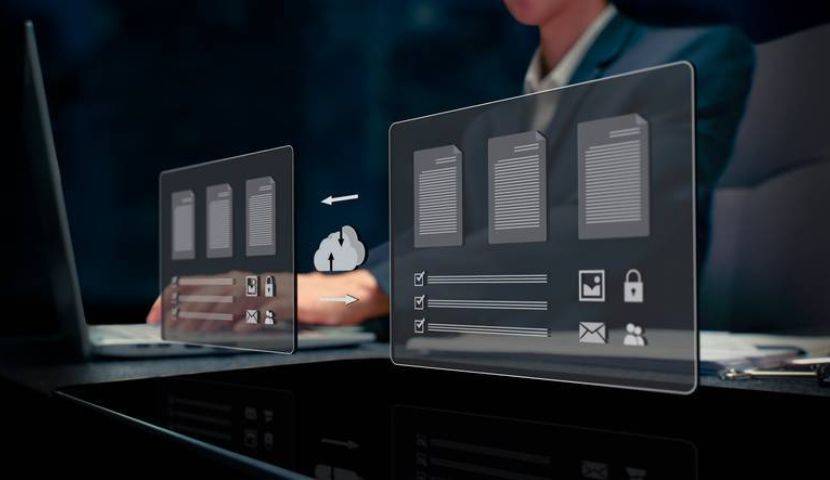Once you have completed implementing an enterprise resource planning (ERP) system in your organization, you expect the system to start delivering the promised benefits and ROI. But how effective the ERP software can be depends in part on how effective your data migration process is.
An ERP data migration project involves transferring data and information—such as master data, transactional data, configuration data and historical data—from your legacy systems to the new ERP system. This process can determine the success or failure of your ERP implementation. It’s therefore crucial to understand some of the common challenges that organizations face during the data migration process to ensure a smooth transition to the new ERP system and avoid costly delays with your project.

Data Migration Best Practices
Download the eBook to discover ERP data migration best practices to ensure a smooth transition.
Common ERP Data Migration Challenges
1. Ensuring Data Accuracy and Integrity
Maintaining the accuracy and integrity of the data being transferred from your legacy systems to the new ERP system is one of the most significant ERP data migration challenges. As a manufacturer or distributor running on legacy systems and processes it’s highly likely that you have stored your data and information across multiple systems—such as:
- Customer data in your customer relationship management (CRM) system
- Supply chain data in your supply chain management (SCM) system
- Manufacturing data in your manufacturing execution system (MES)
- Warehouse inventory data in your warehouse management system (WMS)
Even though these systems might have been functional at one point, transferring this data to your new ERP system can bring about issues, such as:
Duplicate Records
Storing data in different systems could result in having duplicate records for customers, products and other information. When not properly addressed during ERP migration, duplicate information can lead to incorrect reporting, making it a challenge to make important business decisions.
Inconsistent Data Formats
Different systems have a variety of ways (formats) of storing data. For example, they may have different ways of storing dates and addresses.
Incomplete or Missing Data
Missing and incomplete data can be present in your old system, creating gaps in information available in the new ERP system.
To overcome these ERP data migration challenges, investing in data profiling and data cleansing tools can help identify and resolve data quality issues before migration. Also, establish a clear data governance framework that defines data ownership, quality standards and maintenance processes to ensure ongoing data accuracy and data integrity post-migration.

2. Managing Complex Data Structures
Manufacturers and distributors deal with complex data structures to manage operations and data flow, such as bill of materials (BOM), work orders, process flowcharts, inventory management and order processing among others. The relationship between the various data elements brings about a challenge when migrating the data to the new ERP system.
Hierarchical Data Structures
Mapping and migrating BOMs and other hierarchical data structures can be a difficult process. It’s crucial to maintain the relationships between so-called “parent and child” components during the ERP migration process for accurate production planning and inventory management.
Customized Data Fields
Legacy systems often have customized data fields that may not have a direct equivalent in the new ERP system. Input from various stakeholders is required to determine how this data is mapped or whether to migrate them all to the new ERP system.
Integration with Third-Party Systems
Integrating third party systems used for specific functions—such as quality control or logistics—with a new ERP system is a difficult task that necessitates careful planning and coordination. These third-party platforms usually contain unique data formats and communication protocols, creating a need to build custom bridges between the applications.
Work in collaboration with your ERP implementation partner to develop a comprehensive data migration strategy incorporating the unique data structures in these systems. This complex process can involve accurate data mapping by creating custom scripts and use of other specialized data migration tools, guaranteeing that all your data is transferred to the new ERP system.
Ready to start your digital transformation journey?
Click the button below to request your free discovery call.

“If your data is housed in a multitude of databases one of the biggest challenges is locating the disparate databases and normalizing the data. Auditing your data can help identify what you have, what you need to move and what needs to remain.”
Gilad David Maayan, Agile SEO
3. Allocating Sufficient Resources
An ERP project is a resource-intensive undertaking, and the data migration phase requires significant resources for the process to go on smoothly. This process requires sufficient time, money and skilled personnel. Setting aside insufficient resources can result in project delays, budget overruns and increased risk of data loss and corruption.
Budgeting for Data Migration
Sufficient funds—including costs of necessary tools, consultants and temporary staff—must be allocated for the data migration process.
Staffing the Migration Team
The ERP migration phase requires a team of both technical and business experts. The team put in place must be able to handle the migration process without compromising their other day-to-day duties. Hiring temporary staff or outsourcing some tasks to external partners may be necessary to guarantee that your data migration team is well-balanced.
Timeline Management
Data migration is a time-consuming process, therefore, it’s essential to set realistic timelines for this process. The data must also be thoroughly tested before the go-live phase.
Developing a comprehensive resource plan can help mitigate these challenges. The plan must outline clearly the budget to be used, staffing and responsibilities and timelines for the process to be done to completion. Your organization must also conduct regular progress reviews and risk assessments to identify any potential resource gaps early on and to keep the project on track.

4. Ensuring Stakeholder Buy-In
Many organizations make the mistake of considering data migration an IT project. However, this is a mistake. Data migration requires support from all stakeholders in your different departments. The success of this process requires all relevant parties to be aligned and engaged throughout.
A. Identifying Key Stakeholders
To secure stakeholder buy-in and support, the first step must be identifying the key people who will be impacted by the data migration process—such as representatives from finance, operations, sales and other departments. When your stakeholders are involved early on in the process, your organization can understand and deal with their requirements and concerns early on. The end result is good stakeholder buy-in throughout the data migration process, helping to move the project forward.
B. Communicating the Benefits and Risks
Your key stakeholders must also understand how important the data migration process is and how it can benefit them and your organization as a whole. Clearly communicating the benefits of data migration, including improved data accuracy and streamlined business processes, can help them understand this. Also, your stakeholders must understand the potential risks involved with the data migration process, such as temporary disruptions to business operations.
C. Managing Resistance to Change
There are significant changes to existing data, processes and workflows when carrying out data migration, and this can be met with resistance from your employees. Providing training, support and clear communication about why the change is necessary can help address any resistance.
Developing a comprehensive change management plan must also establish a clear governance structure. It defines the roles, responsibilities and decision-making authority to help keep stakeholders aligned and working together towards the same goal—a successful data migration process.

Learn more about Ultra's consulting services.
5. Addressing Data Security and Compliance
One of the major ERP data migration challenges is ensuring sensitive data is protected throughout the process. Sensitive data—such as customer details and intellectual property—must be protected from unauthorized access, to avoid costly fines and reputational damage.
A. Data Encryption and Access Controls
The data migration process involves extracting the data, transforming it and loading it into the new ERP system. This process can expose your sensitive data to unauthorized personnel. Establishing appropriate encryption and access controls can help protect this data from unauthorized access and data breaches.
B. Regulatory Compliance
GDPR and HIPAA are some of the regulations that manufacturers and distributors are subjected to, depending on materials used in the manufacturing process and the products’ intended use. During the data migration process, your organization must ensure that the process and the new ERP system are fully compliant with all industry-specific regulations to avoid penalties and legal liabilities.
C. Data Retention and Archiving
Your company must ensure that the new ERP system has the capabilities to support data retention and archiving requirements. This is crucial because some regulations require retaining certain types of data for a specified period of time. Other regulations require the secure destruction of data after a certain period of time.
Developing a comprehensive data security and compliance plan can help deal with the data security-related ERP data migration challenges. This process can involve:
- Conducting risk assessments
- Implementing additional security measures
- Ensuring that all relevant stakeholders are trained on the new system’s security and compliance features
Migrations are time-intensive which translates to overhead costs for labor that goes into running pretty much everything that follows in this list. In addition, there are often hard costs associated with a data migration.
Beth Fuller, OpenContext
6. Managing Data Validation and Testing
To ensure the accuracy, completeness and functionality of the data in the new ERP system, data validation and testing are essential. Data validation and testing also helps prevent data corruption, system errors and business disruptions.
A. Developing a Comprehensive Testing Plan
Testing plans that cover all aspects of the migrated data, including data accuracy, relationships and integration with other systems, must be developed by your migration team. The plan should include:
- Specific test scenarios
- Expected results
- Acceptance criteria
B. Allocating Time for Testing
Testing and validating the migrated data must not be rushed. Sufficient time must be allocated to avoid missing errors and increasing the risk of post-migration issues. Contingency plans must also be put in place to deal with any issues that may be noticed during this process.
C. Involving End Users in Testing
One way to ensure that the migrated data is meeting the needs of the end users is by involving them during the testing phase. This will also help determine whether the new ERP system is intuitive and easy to use or not. Key users from every department must be encouraged to participate in user acceptance testing (UAT) and provide feedback on the migrated data.
Data validation and testing should be carried throughout the data migration process and not as a final step. Any issues that are identified from the test results must be dealt with as soon as they arise to help guarantee that the migrated data is accurate, complete and fully functional. Comparing your migrated data with the original data source can further help guarantee the accuracy of your data.
7. Overcoming Technical Compatibility Issues
Your new ERP solution must be compatible with your existing legacy systems and processes. Many older programs are custom-built, industry-specific, and may have different data languages from the new ERP system, bringing about integration challenges. This situation creates data silos and may force your company to have a patchwork of systems which may hinder the flow of information.
A. Legacy System Limitations
Your legacy systems may lack the ability to export your data in a format that is compatible with your new ERP solution. You may need to put in place additional data transformation and mapping efforts, and this can increase the complexity of your data migration process.
B. Integration with Third-Party Applications
Quality control, supply chain management, warehouse management systems and customer relationship management are examples of functions that may be using third-party applications in your organization. These applications may require custom APIs or middleware solutions during the migration process which can be challenging.
C. Infrastructure Compatibility
A new ERP system typically has the latest technological advancements in terms of hardware specifications or network configurations which may be different from your legacy systems. This necessitates your organization to update and optimize the IT infrastructure to support the new ERP system before you begin the data migration process.
To overcome these technical ERP data migration challenges, conduct a thorough assessment of your existing data, systems and infrastructure with the help of your IT team and implementation partner. This assessment is helpful in identifying potential compatibility issues, allowing you to develop a plan to address them and may involve:
- Upgrading your hardware
- Developing custom integrations
- Phasing out legacy systems over time
Conclusion
Clearly, one of the most crucial phases during an ERP implementation project is data migration, since your organization cannot enjoy the benefits an ERP system promises by migrating data with errors to the new ERP system. For there to be a successful data migration process and smooth transition from legacy systems to the new ERP system, your stakeholders, project team and external partners must work in collaboration and develop a data migration plan. This plan can identify potential roadblocks in dealing with any ERP data migration challenges your organization is likely to face.
Ultra Consultants is here to help your organization through this crucial step in ERP implementation. With our expertise and proven project management methodology—gained from hundreds of successful ERP implementation projects—we can help your organization through the data migration phase. We ensure that your new ERP system has clean, correct data that can be used to make critical business decisions you need to move your business forward.
Table of Contents
More ERP material...
AI in Food and Beverage Manufacturing
Discover how AI is revolutionizing food and beverage manufacturing, enhancing quality, reducing…
How ERP for Quality Control Eliminates Manual Documentation Chaos
This post will examine why managing quality records outside of an ERP…
Assessing Your AI Maturity
This article breaks down how businesses can measure their AI maturity to…



